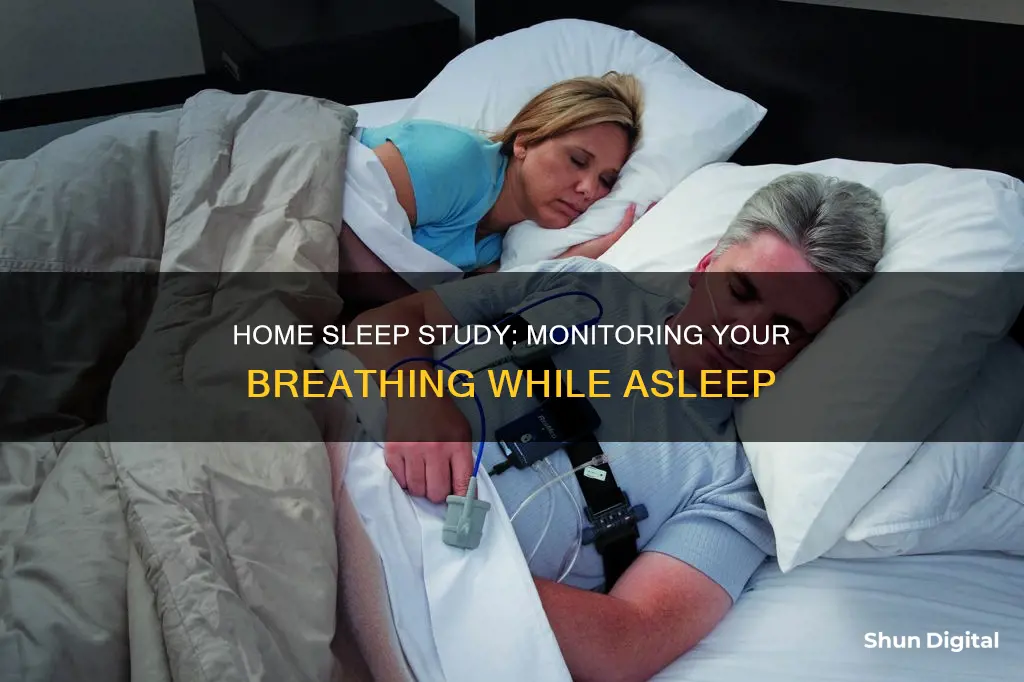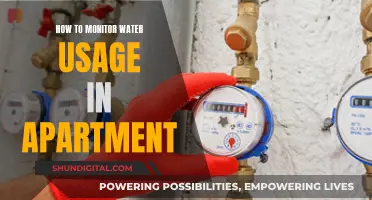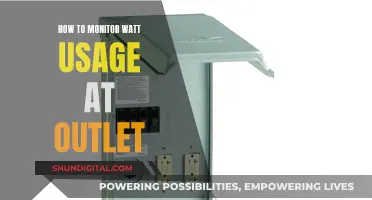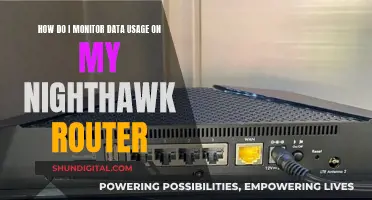
Home sleep tests are a convenient and cost-effective way to diagnose sleep apnea, a disorder that causes temporary pauses in breathing during sleep. These tests are designed to monitor various aspects of sleep, including breathing patterns, oxygen levels, heart rate, body movement, and sleep position. They are typically conducted overnight and involve wearing sensors that track these parameters. While home sleep tests offer privacy and flexibility, they may not be as accurate as monitored lab tests in detecting sleep apnea or other sleep disorders. It is important to consult a doctor to determine the most suitable testing method based on individual needs and symptoms.
| Characteristics | Values |
|---|---|
| Purpose | To diagnose sleep apnea |
| Type of data collected | Respiratory activity, breathing patterns, chest motion, heart rate, blood oxygen level, sleep position, snoring events and intensity |
| Cost | $100 to $500 |
| Comparison to in-lab sleep study | More convenient, flexible, and less costly |
| Accuracy | Highly accurate for moderate to severe sleep apnea, less accurate for mild cases |
| Sensors | Nasal breathing sensor, effort belt, pulse oximeter, microphone, data collection device |
| Test procedure | Meeting with a medical professional, getting the equipment, doing the test, returning the equipment, discussing results |
What You'll Learn

Home sleep tests are a cost-effective alternative to in-lab studies
However, it is important to note that home sleep tests may not be as accurate as in-lab studies. They are more vulnerable to errors, such as sensors falling off during the test, and may not capture all the data needed to diagnose sleep apnea or other sleep disorders. In some cases, a home sleep test may not rule out sleep apnea, and further testing in a lab may be necessary.
- Schedule a visit with a medical professional: A prescription is required for a home sleep test, so if you are experiencing symptoms of sleep apnea, meet with your healthcare provider. Many companies offer virtual consultations for this purpose.
- Get your home sleep test: Once you have a prescription, the equipment will be mailed to you or you can pick it up at a sleep lab or clinic.
- Take the test: Follow the instructions provided to set up the sensors and devices required for the test. Try to maintain your normal sleep schedule and avoid caffeine and alcohol, as they can affect your sleep.
- Return your equipment: Unless you have a disposable test, return the equipment to the predetermined location.
- Await your results: Once the data has been analyzed, your doctor or sleep specialist will discuss the results with you and determine the next steps.
The equipment used for home sleep tests may include:
- Nasal breathing sensor: Tubes placed in the nostrils to analyze breathing patterns.
- Effort belt: A band placed around the chest to measure movement associated with breathing, differentiating between obstructive and central sleep apnea.
- Pulse oximeter: A device placed over a fingertip to measure blood oxygen levels.
- Microphone: Used to measure snoring, either attached to the neck or as part of the nasal breathing sensor.
- Data collection device: All the sensors connect to this device, which may have buttons to start and stop data collection and status lights to indicate recording.
Home sleep tests are generally categorized as Type 3 or Type 4 tests since they collect less data than Type 1 (gold standard polysomnography) and Type 2 tests. Type 3 tests measure two breathing-related measures (e.g., airflow and breathing effort) and one heart-related measure (e.g., heart rate). Type 4 tests collect one or two measures, such as airflow, blood oxygen levels, and heart rate, and are typically used for screening.
While home sleep tests offer convenience and cost savings, they may not be suitable for everyone. If you are at risk for other sleep issues, such as restless leg syndrome or narcolepsy, or have underlying health conditions, a more comprehensive in-lab study may be recommended.
Talk to your healthcare provider to determine if a home sleep test is right for you and to ensure you are using a test from a reputable company that has been prescribed by a qualified physician.
Breaking Free: Strategies for Ankle Monitor Removal
You may want to see also

They monitor breathing, not sleep
Home sleep tests are a convenient and cost-effective alternative to traditional in-lab sleep studies. They are designed to help diagnose obstructive sleep apnea (OSA) and involve wearing a portable breathing monitor overnight. However, it is important to note that these tests monitor breathing and not actual sleep.
Home sleep tests typically use sensors to detect breathing patterns and measure various parameters related to breathing and oxygen levels. These may include respiratory activity, breathing patterns, chest motion, oxygen saturation, heart rate, and snoring events. The focus is on breathing rather than sleep, as the tests are specifically designed to evaluate patients for sleep apnea.
While home sleep tests offer many benefits, they also have some limitations. They do not capture information about total sleep time, nighttime awakenings, or sleep stages. As a result, they cannot be used to diagnose non-breathing-related sleep disorders such as narcolepsy. Additionally, home sleep tests may not be as accurate as in-lab sleep studies due to the potential for sensors to dislodge or malfunction during the test.
In summary, home sleep tests are a valuable tool for diagnosing sleep apnea, but they monitor breathing parameters rather than sleep itself. They offer a simplified and cost-effective approach, but they may not provide a comprehensive assessment of sleep issues. For a more thorough evaluation, an overnight sleep study in a lab attended by a sleep technologist is recommended.
Fabric-Seated Camry: Blind Spot Monitor Feature?
You may want to see also

Sensors are used to detect breathing patterns
The sensors used in home sleep studies are non-invasive and can be worn overnight. They are designed to be comfortable and not interfere with the user's sleep. The sensors detect changes in breathing patterns, such as the rate and volume of breaths, by measuring parameters such as airflow, blood oxygen levels, and body movement.
- Finger Sensors: A small probe or sensor is placed on the finger to measure oxygen levels in the blood. This information can help determine if the person is getting enough oxygen while sleeping.
- Nostril Sensors: A mask with tubes is inserted into the nostrils and secured around the ears, similar to an oxygen mask. This measures the airflow and can detect any obstructions or disruptions in breathing.
- Abdomen and Chest Sensors: Sensors are placed on the abdomen and chest to measure their rise and fall during breathing. This helps detect the depth and frequency of breaths.
- Wristband Sensors: A wristband with sensors can measure parameters such as heart rate, blood oxygen level, and body movement. It is a comfortable and non-invasive way to collect data during sleep.
- Chest Patch Sensors: A chest patch with sensors can measure multiple parameters, including electrocardiogram (ECG), skin impedance, photoplethysmography (PPG), and body movement. This provides comprehensive data on the person's sleep and can help detect any abnormalities.
Troubleshooting Studio Monitors: Could It Be a Blown Fuse?
You may want to see also

A doctor's prescription is required for the test
A doctor's prescription is required for a home sleep test. This is not an over-the-counter test. Your primary care physician or a physician at a sleep clinic can order it for you to use at home.
The process generally involves five steps: First, schedule a visit with a care provider. A prescription is required to get a home sleep test, so if you are experiencing symptoms of OSA, make an appointment with your provider. Many home sleep test companies offer virtual consultations for this purpose as well. If the provider thinks you could have sleep apnea, they will either prescribe you a home sleep test or refer you to a sleep specialist or sleep clinic.
Second, get your home sleep test. Once you have your prescription, depending on the device, it will either be mailed to you or you will need to pick it up at a sleep lab or clinic. When you get the equipment, your provider will walk you through how to use it.
Third, take the test. Once you have the equipment, follow the instructions to put on any sensors required by the test. Try to go to sleep and wake up at your normal times and avoid caffeine and alcohol, as they can affect your sleep. If you usually take sleep medications, ask your doctor if it is appropriate to take them the night of the test.
Fourth, return your equipment. Unless you have a disposable test, bring or send the test back to the location predetermined by your provider. Once the clinic receives the equipment, they will download and analyze the collected data.
Fifth, await your results. Once the data has been analyzed, your doctor or sleep specialist will discuss the results with you. They might give you a sleep apnea diagnosis and prescribe treatment such as a continuous positive airway pressure (CPAP) machine. Alternatively, they might inform you that your results were negative or inconclusive and ask that you undergo an in-lab sleep study.
Home sleep tests are only used to diagnose sleep-disordered breathing issues, like sleep apnea. In-lab sleep studies can help diagnose other sleep disorders, like narcolepsy and periodic limb movement disorders. The difference is in what the test measures. Though both usually measure airflow, blood oxygen levels, and heart rate, only in-lab sleep studies measure sleep by monitoring brain activity.
People often prefer a home sleep study to an in-lab study because they are less expensive and don’t require traveling to a sleep lab. A home test also involves fewer sensors attached to you as you sleep, so it may feel less invasive.
Astro Headphones and Asus Monitors: Easy Setup Guide
You may want to see also

The test is simple and convenient
Home sleep tests are a convenient alternative to in-clinic sleep studies. They are designed to make testing more accessible and help ensure people get the treatment they need. The process is simple and involves five steps:
- Meeting with a medical professional
- Getting the equipment
- Doing the test
- Returning the equipment
- Meeting again to discuss your results
Firstly, schedule a visit with a care provider. A prescription is required to get a home sleep test, so if you are experiencing symptoms of OSA, make an appointment with your provider. Many home sleep test companies offer virtual consultations for this purpose. If the provider thinks you could have sleep apnea, they will either prescribe you a home sleep test or refer you to a sleep specialist or sleep clinic.
Once you have your prescription, the equipment will either be mailed to you or you will need to pick it up at a sleep lab or clinic. When you get the equipment, your provider will walk you through how to use it.
After you have the equipment, follow the instructions to put on any sensors required by the test. Try to go to sleep and wake up at your normal times and avoid caffeine and alcohol, as they can affect your sleep. If you usually take sleep medications, ask your doctor if it is appropriate to take them the night of the test.
Unless you have a disposable test, bring or send the test back to the location predetermined by your provider. Once the clinic receives the equipment, they will download and analyze the data.
Finally, once the data has been analyzed, your doctor or sleep specialist will discuss the results with you. They might give you a sleep apnea diagnosis and prescribe treatment, or they might inform you that your results were negative or inconclusive and ask that you undergo an in-lab sleep study.
Home sleep tests are generally more convenient than polysomnography (PSG) as they can be done in the comfort of your own home. They are also more affordable, with at-home tests costing between $100 to $500 compared to in-lab tests, which can cost thousands of dollars. In-lab tests can also be inconvenient, as they require you to travel to a sleep clinic and spend the night in an unfamiliar environment.
Ensuring Monitor Compatibility: A Step-by-Step Guide for Beginners
You may want to see also
Frequently asked questions
A home sleep study is a test that can be used to diagnose sleep apnea. It involves wearing a portable breathing monitor overnight to track your breathing and oxygen levels.
You will need a prescription from your doctor to obtain a home sleep study. The equipment will then be delivered to you or you will need to pick it up from a sleep lab or clinic. The equipment includes sensors that you attach to your body to monitor your breathing, oxygen levels, and other metrics. You then return the equipment to the sleep lab or clinic so they can analyse the data.
The cost of a home sleep study in the US is typically between $150 and $500, and they are often covered by insurance.
Home sleep studies are highly accurate at detecting sleep apnea in people with moderate to severe forms. They may be less accurate for people with mild cases of sleep apnea.
People usually only take a home sleep study once. If further testing is required, an in-lab sleep study may be recommended.







